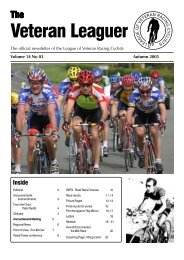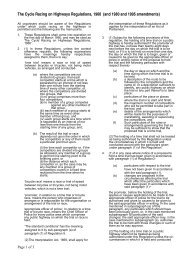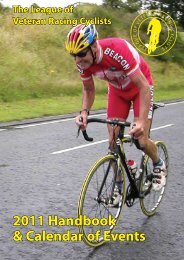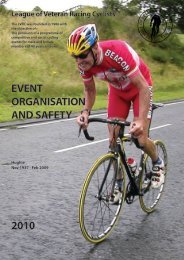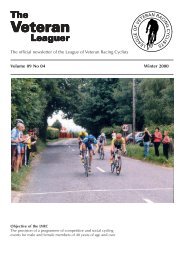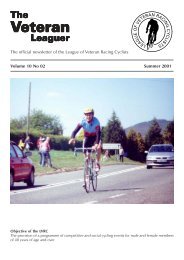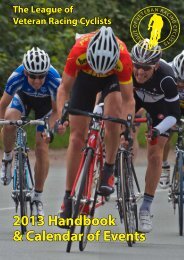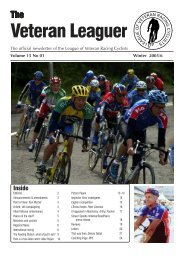Create successful ePaper yourself
Turn your PDF publications into a flip-book with our unique Google optimized e-Paper software.
That creak may be Nature’s way of telling you that your next frame should be a Zimmer – or perhaps<br />
a good stretch will do …<br />
Muscle bound<br />
Auriel Forrester<br />
MUSCLE IS OF THREE different<br />
types: smooth muscle,<br />
cardiac muscle and skeletal<br />
muscle. The first is found surrounding<br />
hollow organs such as in the wall of the<br />
gut, around the bladder and womb, and<br />
in the walls of arteries and veins. We<br />
cannot control these muscles and hence<br />
they are referred to as ‘involuntary’. As<br />
its name implies, cardiac muscle is found<br />
only in the heart muscle itself. One of<br />
the unique features of cardiac muscle is<br />
that it can contract repeatedly many<br />
times a minute for a great many years –<br />
fortunately without a rest. Finally, skeletal<br />
muscles are those involved in movement<br />
and support – a function often overlooked,<br />
yet a crucially important role of<br />
muscles and one where weaknesses lead<br />
to problems. Skeletal muscle is also<br />
referred to as ‘voluntary’, for fairly<br />
obvious reasons.<br />
A muscle is made up of thousands of<br />
muscle fibres bundled together and<br />
wrapped in connective tissue. While the<br />
muscle fibres themselves are elastic in<br />
nature this tissue is very fibrous – a type<br />
of collagen. In young children this<br />
collagen is very soft and its fibres run<br />
parallel to the muscle fibres, helping to<br />
make the muscle more pliable and<br />
resistant to injury. As we get older the<br />
collagen fibres become more knotted<br />
and twisted – rather like hair that has<br />
never been combed. Such tissue is very<br />
inflexible and non-pliable and thus more<br />
prone to tearing. Tears are then repaired<br />
with further knotted collagen (a form of<br />
scar tissue) making the matter worse.<br />
These knots are what can be felt when<br />
the legs are massaged – indeed massage<br />
can help re-align the collagen<br />
fibres, akin to combing the hair.<br />
The analogy is a good one because<br />
knotted hair could easily be<br />
damaged if the teasing out was not<br />
extremely gentle. Thus these<br />
knotted collagen fibres can be blamed<br />
for at least some of the loss of flexibility<br />
in older people including athletes.<br />
Furthermore, it is believed that knotted<br />
fibrous connective tissue around muscle<br />
fibres reduces the ability of a muscle to<br />
contract forcibly and so reduces the<br />
amount of power produced.<br />
Things are made worse because the<br />
natural fluid levels within muscle tissue<br />
decreases as the muscle ages. This means<br />
that the muscle is less pliable and more<br />
injury-prone. Muscular aches after<br />
training or racing can often be explained<br />
by microscopic damage to muscle cells<br />
and some of the valuable fluid leaking<br />
out. This can best be treated using a cold<br />
compress on the area followed the next<br />
day by warmth to promote healing and<br />
some gentle stretching and mobility as<br />
described later in this article. Older<br />
muscles are more prone to injury and<br />
take longer to heal so every effort should<br />
be made to reduce injury risks however<br />
minor the resulting injury might be.<br />
Movements where the thigh is having to<br />
brake the movement of the body such as<br />
in squash, running or badminton are<br />
likely to cause micro-tears; similarly the<br />
‘lowering phase’ in weight lifting is more<br />
of a risk than the ‘raising phase’. The new<br />
range of isokinetic and assisted-effort<br />
machines appearing in many health clubs<br />
are designed to reduce such injury risks.<br />
Muscular pain should not be confused<br />
with joint pain although the treatments<br />
are actually very similar. The main joints<br />
of our skeletal system are made up of<br />
cartilage-lined pockets surrounding the<br />
juxtaposed ends of the bones making up<br />
the joint – not unlike the gaiters in cars, I<br />
am told. These pockets are filled with a<br />
viscous fluid. In young people the<br />
cartilage provides a smooth surface for<br />
the bones to move over each other, the<br />
fluid lubricating the joint. As we get older<br />
the cartilage becomes worn and less<br />
smooth and the fluid becomes thicker<br />
and therefore a less effective lubricant –<br />
hence the creaking joints that are all too<br />
familiar. The answer here is to reduce the<br />
weight-bearing load on the joints (so<br />
cycling or rowing are much better than<br />
running), and to ensure the joints are<br />
adequately warmed up before any load is<br />
placed on them and kept warm through<br />
sensible clothing. By load, I don’t just<br />
mean weight-bearing load but also the<br />
load placed by bigger gears. Warming up<br />
is best achieved by a repeated action<br />
with minimal load – such as gently<br />
revving a low gear. Such repeated actions<br />
warm the joint and active muscles<br />
up through friction, increased blood<br />
flow to the region and the heat<br />
produced by muscular activity – the<br />
burning of calories.<br />
Muscles perform a supportive role<br />
as well as movement. This is<br />
achieved through a balancing act<br />
between pairs of postural muscles –<br />
such as the muscles of the back and<br />
abdomen, or through stabilising a joint<br />
by holding the bones together such as<br />
the ‘teres’ muscle groups in the shoulders.<br />
Weaknesses in these muscles –<br />
either caused through injury or lack of<br />
use – will inevitably affect posture,<br />
mobility and strength. Your training<br />
programme will therefore need to<br />
include exercises to strengthen and<br />
mobilise these muscles and associated<br />
joints. In addition to an adequate warmup<br />
the key to reducing injury risk is to<br />
keep the muscle supple and the joints<br />
mobile. This does not mean a rigorous<br />
stretching regime but more a programme<br />
of gentle mobilisation exercises undertaken<br />
when the region is warm – say after<br />
a bath or light exercise session. The joint<br />
should be worked through its current<br />
natural range of movement – say knee<br />
raises assisted by hugging the thigh, then<br />
gradually increasing the range as far as is<br />
comfortable. Any position – in the<br />
Page 14 <strong>Veteran</strong> Leaguer: Winter 2002



